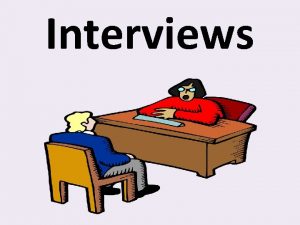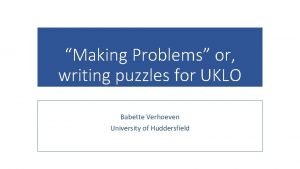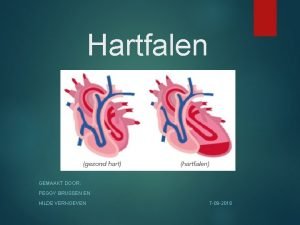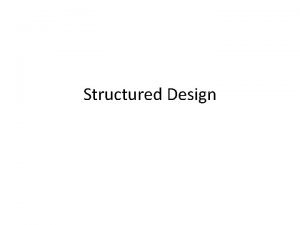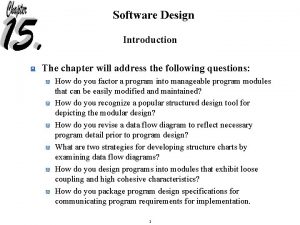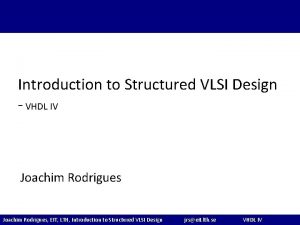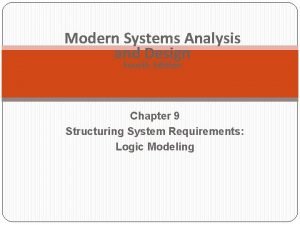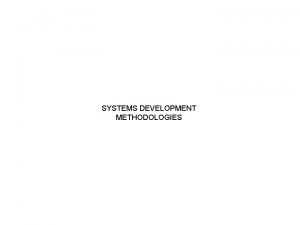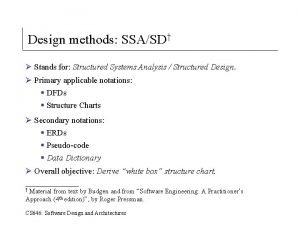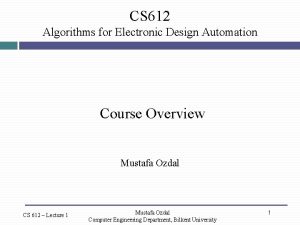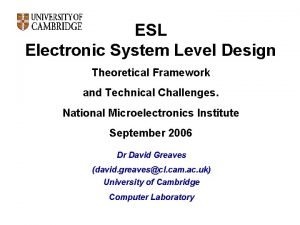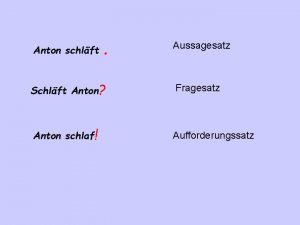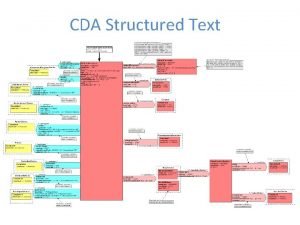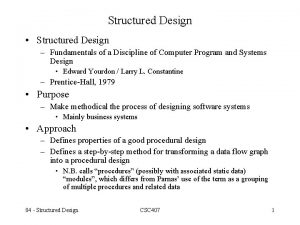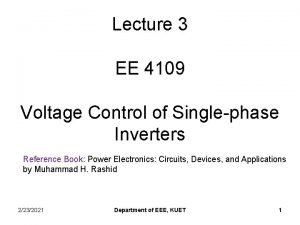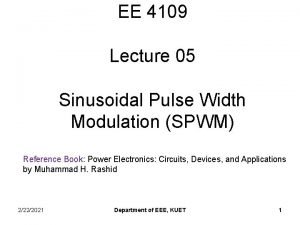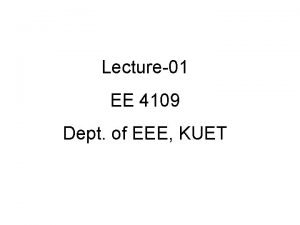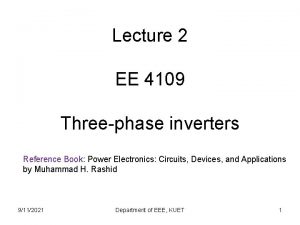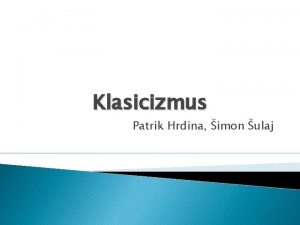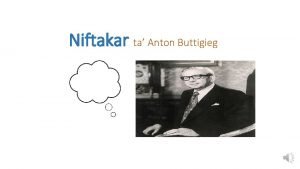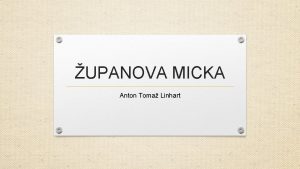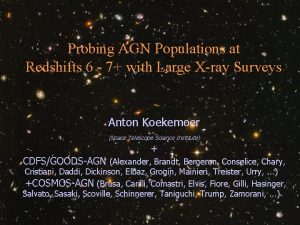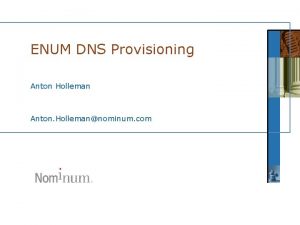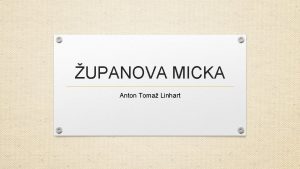Structured Electronic Design EE 4109 Chris Verhoeven Anton






















- Slides: 22

Structured Electronic Design EE 4109 Chris Verhoeven Anton Montagne 1

Staff and schedule Week Anton Montagne 2. 1 2. 2 Chris Verhoeven 2. 3 2. 4 Marion de Vlieger Secretary 2. 5 2. 6 2. 7 2. 9 Date 12 -11 -19 14 -11 -19 19 -11 -19 21 -11 -19 26 -11 -19 28 -11 -19 3 -12 -19 5 -12 -19 10 -12 -19 12 -12 -19 17 -12 -19 19 -12 -19 7 -1 -20 9 -1 -20 21 -1 -20 Day Tuesday Thursday Tuesday Thursday Tuesday Time 15: 45 -17: 30 13: 45 -15: 30 15: 45 -17: 30 13: 45 -15: 30 13: 30 -16: 30 Room D@ta Pi D@ta Pi Exam 2

Exam (way to pass this course) 1. Written exam, open book. Because of low number of students: Standard written becomes standard oral (via appointment) 2. Oral defense of the design based on the design report of the guided design example. During this defense, the student must bring a laptop with simulators and simulation files. The report must be handed in before the exam. During the lectures (and maybe a bit of homework) 2. Oral defense : grade 2+ Complete design: grade + 3 EC masterclass 3

SLi. CAP Symbolic Linear Circuit Analysis Program More than a symbolic network simulation tool: ‘Symbolic SPICE’ Helps setting up and solving design equations MATLAB® application Free of use (Creative Commons Attribution-Non-Commercial No-Derivatives 4. 0 International License) You need a laptop with MATLAB® installed. https: //www. analog-electronics. eu/slicap. html SLi. CAP will be used during the defense of the design, not in the standard (oral) exam 4

Book Now available from Delft Academic Press First Edition

Education levels: Bloom for engineers 4, 5, 6: Analyze, Evaluate, Synthesize 3: Apply Level 2: Understand TU-Delft Engineer 1: Remember Design methodology F 6 7 8 9 10

Traditional Bloom Cycle for Electronic Engineers 3: Apply Active education until level 4 Repeat existing designs Analyze results Tweak designs to meet specs Gradually develop a personal design methodology 2: Understand Student 1: Remember 4: Analyze 5 6 Design methodology “Experience” t?

Repeat Analyze Tweak “Experience”

No “tweaking” of accidentally available circuit Vacuum tube radio Transistor technology Vacuum tube architecture

Bloom Cycle for Innovators Active education including level 5 and 6 and operationalization 3: Apply 4: Analyze 2: Understand 5: Evaluate The full circle 4: Analyze 6: Synthesize Creative Structured and independent Design methodology thinking 1: Remember Operationalization Realization

Not in this course 6: Synthesize ology Inferior top cessary e n n a h t s e More issu Creative and independent thinking Operationalization

In this course There are specifications There is no circuit, so: No simulations to “optimize” No “tweaking” of existing hardware S p e c s 6: Synthesize Creative and independent thinking HOW? : Create a design yourself Operationalization

Structured Electronic Design by creating a design…

Building the “bridge” Top-down design Customer Hardware comes from the bottom Show-stoppers come from the bottom Biased transistor Bottom-up design e ar w -a om t t o “B n w do p to ” n ig s de Design Methodology Circuits technology Specifications come from the top

Our Customer: Low Frequency Radio Astronomers 15

“Hydrogen line” at 1420 MHz Expanding universe: Objects move away Red-shift: frequency goes down Looking deeper in space and deeper into the past means: Looking for largely redshifted hydrogen lines OLFAR and LUFAR: 30 k. Hz – 30 MHz 16

Sky at 4. 7 MHz RAE-2 all-sky map of the galaxy at 4. 70 MHz by J. C. Novaco & L. W. Brown (1978) [2] 17

A resonant antenna The length of the resonant antenna is ½ ( = wavelength) OLFAR and LUFAR: 30 k. Hz – 30 MHz OLFAR and LUFAR: 10 km – 10 m (RAE 1, 4. 7 MHz: 64 m) https: //en. wikipedia. org/wiki/Antenna_(radio) 18

? Short Antenna model 19

From antenna to radio Cable 20

Impedance matching c 299792458 cable reduction of c 0, 66667 c in cable 199861638, 7 cable length 6 delay cable 3, 00208 E-08 delay cable [ns] 30, 02076857 return delay [ns] 6, 00415 E-08 Lowest Resonant frequency at cable = 0. 5 Wavelength Lowest Resonant Frequency 16655136, 56 Lowest Resonant Frequency [MHz] 16, 65513656 m/s m s ns s Hz MHz 21

The LNA Active Antenna LNA 22
 Structured analysis and structured design (sa/sd)
Structured analysis and structured design (sa/sd) Types of interviews structured semi structured unstructured
Types of interviews structured semi structured unstructured Babette verhoeven
Babette verhoeven Uklo
Uklo Babette meijer
Babette meijer Create.kahoot
Create.kahoot An electronic is the electronic exchange of money or scrip
An electronic is the electronic exchange of money or scrip Electronic news gathering and electronic field production
Electronic news gathering and electronic field production Structure data tool
Structure data tool Structured design example
Structured design example Structured systems analysis and design methodology
Structured systems analysis and design methodology The primary tool used in structured chart is a
The primary tool used in structured chart is a Sadt structured analysis and design technique
Sadt structured analysis and design technique Structured vlsi design
Structured vlsi design Parallel development process
Parallel development process Ssadm diagram
Ssadm diagram Structured english in system analysis and design
Structured english in system analysis and design Ssadm
Ssadm A goal of producing process specifications is to:
A goal of producing process specifications is to: Structured system development methodology
Structured system development methodology List the five basic steps of ssa/sd process
List the five basic steps of ssa/sd process Cs 612
Cs 612 Esl design
Esl design

